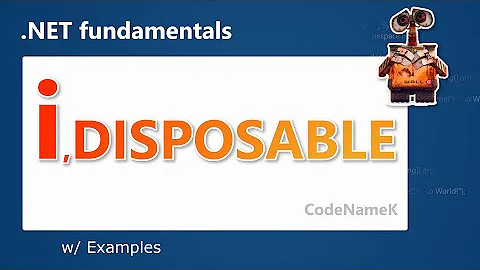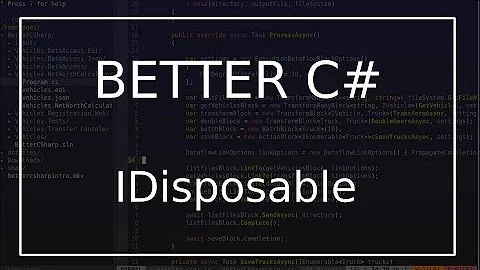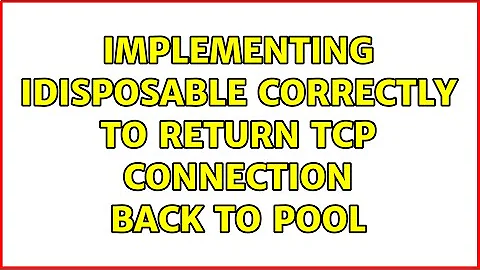Implementing IDisposable correctly
Solution 1
This would be the correct implementation, although I don't see anything you need to dispose in the code you posted. You only need to implement IDisposable when:
- You have unmanaged resources
- You're holding on to references of things that are themselves disposable.
Nothing in the code you posted needs to be disposed.
public class User : IDisposable
{
public int id { get; protected set; }
public string name { get; protected set; }
public string pass { get; protected set; }
public User(int userID)
{
id = userID;
}
public User(string Username, string Password)
{
name = Username;
pass = Password;
}
// Other functions go here...
public void Dispose()
{
Dispose(true);
GC.SuppressFinalize(this);
}
protected virtual void Dispose(bool disposing)
{
if (disposing)
{
// free managed resources
}
// free native resources if there are any.
}
}
Solution 2
First of all, you don't need to "clean up" strings and ints - they will be taken care of automatically by the garbage collector. The only thing that needs to be cleaned up in Dispose are unmanaged resources or managed recources that implement IDisposable.
However, assuming this is just a learning exercise, the recommended way to implement IDisposable is to add a "safety catch" to ensure that any resources aren't disposed of twice:
public void Dispose()
{
Dispose(true);
// Use SupressFinalize in case a subclass
// of this type implements a finalizer.
GC.SuppressFinalize(this);
}
protected virtual void Dispose(bool disposing)
{
if (!_disposed)
{
if (disposing)
{
// Clear all property values that maybe have been set
// when the class was instantiated
id = 0;
name = String.Empty;
pass = String.Empty;
}
// Indicate that the instance has been disposed.
_disposed = true;
}
}
Solution 3
The following example shows the general best practice to implement IDisposable interface. Reference
Keep in mind that you need a destructor(finalizer) only if you have unmanaged resources in your class. And if you add a destructor you should suppress Finalization in the Dispose, otherwise it will cause your objects resides in memory for two garbage cycles (Note: Read how Finalization works). Below example elaborate all above.
public class DisposeExample
{
// A base class that implements IDisposable.
// By implementing IDisposable, you are announcing that
// instances of this type allocate scarce resources.
public class MyResource: IDisposable
{
// Pointer to an external unmanaged resource.
private IntPtr handle;
// Other managed resource this class uses.
private Component component = new Component();
// Track whether Dispose has been called.
private bool disposed = false;
// The class constructor.
public MyResource(IntPtr handle)
{
this.handle = handle;
}
// Implement IDisposable.
// Do not make this method virtual.
// A derived class should not be able to override this method.
public void Dispose()
{
Dispose(true);
// This object will be cleaned up by the Dispose method.
// Therefore, you should call GC.SupressFinalize to
// take this object off the finalization queue
// and prevent finalization code for this object
// from executing a second time.
GC.SuppressFinalize(this);
}
// Dispose(bool disposing) executes in two distinct scenarios.
// If disposing equals true, the method has been called directly
// or indirectly by a user's code. Managed and unmanaged resources
// can be disposed.
// If disposing equals false, the method has been called by the
// runtime from inside the finalizer and you should not reference
// other objects. Only unmanaged resources can be disposed.
protected virtual void Dispose(bool disposing)
{
// Check to see if Dispose has already been called.
if(!this.disposed)
{
// If disposing equals true, dispose all managed
// and unmanaged resources.
if(disposing)
{
// Dispose managed resources.
component.Dispose();
}
// Call the appropriate methods to clean up
// unmanaged resources here.
// If disposing is false,
// only the following code is executed.
CloseHandle(handle);
handle = IntPtr.Zero;
// Note disposing has been done.
disposed = true;
}
}
// Use interop to call the method necessary
// to clean up the unmanaged resource.
[System.Runtime.InteropServices.DllImport("Kernel32")]
private extern static Boolean CloseHandle(IntPtr handle);
// Use C# destructor syntax for finalization code.
// This destructor will run only if the Dispose method
// does not get called.
// It gives your base class the opportunity to finalize.
// Do not provide destructors in types derived from this class.
~MyResource()
{
// Do not re-create Dispose clean-up code here.
// Calling Dispose(false) is optimal in terms of
// readability and maintainability.
Dispose(false);
}
}
public static void Main()
{
// Insert code here to create
// and use the MyResource object.
}
}
Solution 4
IDisposable exists to provide a means for you to clean up unmanaged resources that won't be cleaned up automatically by the Garbage Collector.
All of the resources that you are "cleaning up" are managed resources, and as such your Dispose method is accomplishing nothing. Your class shouldn't implement IDisposable at all. The Garbage Collector will take care of all of those fields just fine on its own.
Solution 5
You need to use the Disposable Pattern like this:
private bool _disposed = false;
protected virtual void Dispose(bool disposing)
{
if (!_disposed)
{
if (disposing)
{
// Dispose any managed objects
// ...
}
// Now disposed of any unmanaged objects
// ...
_disposed = true;
}
}
public void Dispose()
{
Dispose(true);
GC.SuppressFinalize(this);
}
// Destructor
~YourClassName()
{
Dispose(false);
}
Related videos on Youtube
Ortund
I started teaching myself code around 2003 out of a high school computer course I was doing as a part of my curriculum. Very quickly I became filled with a sense of pride as I saw that the code I was writing was creating things so I decided to pursue this as a career. I had a few jobs developing software over the next 10 years during which time I'd learned a lot and developed my skills considerably. In 2013, however, I found myself without a job in an economic climate that didn't favor my prospects for re-employment. I had to find a way to make money fast. Having started my own software development business at that time, I managed to keep my head above water for a few years. In 2017 however, after a few personal setbacks, I decided to go back to the job market. I've since been working for a small software house where I develop and maintain solutions and bespoke data management systems for our clients on a regular basis. Most of these use ASP.NET Web Forms, but as I'm the only employee on staff with experience in MVC, I'm tasked with updating and maintaining all of our MVC properties as well.
Updated on September 26, 2020Comments
-
 Ortund over 3 years
Ortund over 3 yearsIn my classes I implement
IDisposableas follows:public class User : IDisposable { public int id { get; protected set; } public string name { get; protected set; } public string pass { get; protected set; } public User(int UserID) { id = UserID; } public User(string Username, string Password) { name = Username; pass = Password; } // Other functions go here... public void Dispose() { // Clear all property values that maybe have been set // when the class was instantiated id = 0; name = String.Empty; pass = String.Empty; } }In VS2012, my Code Analysis says to implement IDisposable correctly, but I'm not sure what I've done wrong here.
The exact text is as follows:CA1063 Implement IDisposable correctly Provide an overridable implementation of Dispose(bool) on 'User' or mark the type as sealed. A call to Dispose(false) should only clean up native resources. A call to Dispose(true) should clean up both managed and native resources. stman User.cs 10
For reference: CA1063: Implement IDisposable correctly
I've read through this page, but I'm afraid I don't really understand what needs to be done here.
If anyone can explain in more layman's terms what the problem is and/or how
IDisposableshould be implemented, that will really help!-
Claudio Redi over 10 yearsIs that all the code inside
Dispose? -
Daniel Mann over 10 yearsDid you look at the code sample provided in the link you posted?
-
 Belogix over 10 yearsThere is the
Belogix over 10 yearsThere is theIDisposable patternthat you should use / investigate. I am sure you will get lots of answers with details soon but basically it involvesGC.SupressFinalize()and destructor etc. -
user1703401 over 10 yearsYou should implement your Dispose() method to call the Dispose() method on any of the members of your class. None of those members have one. You should therefore not implement IDisposable. Resetting the property values is pointless.
-
jason over 10 yearsYou only need to implement
IDispoableif you have unmanaged resources to dispose of (this includes unmanaged resources that are wrapped (SqlConnection,FileStream, etc.). You do not and should not implementIDisposableif you only have managed resources such as here. This is, IMO, a major problem with code analysis. It's very good at checking silly little rules, but not good at checking conceptual errors. -
 Keith Payne over 10 years@Ortund there is already voluminous material on SO concerning the Disposable pattern. Even in the answers to this question there are subtle examples of misunderstanding the pattern. It is much better to point future questioners to the first related SO question (which has 309 upvotes).
Keith Payne over 10 years@Ortund there is already voluminous material on SO concerning the Disposable pattern. Even in the answers to this question there are subtle examples of misunderstanding the pattern. It is much better to point future questioners to the first related SO question (which has 309 upvotes). -
tjmoore about 10 yearsSo don't downvote, don't upvote, leave the post at zero and close the question with a helpful pointer.
-
-
 Ortund over 10 yearsI was told when I started writing in C# that it's best to make use of
Ortund over 10 yearsI was told when I started writing in C# that it's best to make use ofusing(){ }whenever possible, but to do that, you need to implement IDisposable, so in general, I prefer to access a class through usings, esp. if I only need the class in one or two functions -
Daniel Mann over 10 years@Ortund You misunderstood. It's best to use a
usingblock when the class implements IDisposable. If you don't need a class to be disposable, don't implement it. It serves no purpose. -
Chandramouleswaran Ravichandra about 10 yearsAgree with this - there is a notion of disposing everything when it is actually not needed. Dispose should be used only if you have unmanaged resources to clean up!!
-
Thomas over 9 years@DanielMann The semantics of a
usingblock do tend to be appealing beyond theIDisposableinterface alone, though. I imagine there have been more than a few abuses ofIDisposablejust for scoping purposes. -
Thomas over 9 years+1, having a flag to make sure the cleanup code is executed only once is way, way better than setting properties to null or whatever (especially since that interferes with
readonlysemantics) -
 Matt Wilko over 9 yearsNot strictly true, the Dispose method also allows you to dispose of "managed resources that implement IDisposable"
Matt Wilko over 9 yearsNot strictly true, the Dispose method also allows you to dispose of "managed resources that implement IDisposable" -
Servy over 9 years@MattWilko That makes it an indirect way of disposing of unmanaged resources, because it allows another resource to dispose of an unmanaged resource. Here there isn't even an indirect reference to an unmanaged resource through another managed resource.
-
 Sudhanshu Mishra about 9 yearswouldn't it be wiser to have a call to GC.SuppressFinalize(this) in the destructor as well? Otherwise the object itself would be reclaimed in the next GC
Sudhanshu Mishra about 9 yearswouldn't it be wiser to have a call to GC.SuppressFinalize(this) in the destructor as well? Otherwise the object itself would be reclaimed in the next GC -
schoetbi almost 9 years@dotnetguy: The objects destructor is called when the gc runs. So calling twice is not possible. See here: msdn.microsoft.com/en-us/library/ms244737.aspx
-
Chel almost 9 yearsSo now are we calling any piece of boilerplate code a "pattern"?
-
 Belogix over 8 years@rdhs No we are not. MSDN states it IS a pattern "Dispose Pattern" here - msdn.microsoft.com/en-us/library/b1yfkh5e(v=vs.110).aspx so before down-voting maybe Google a little?
Belogix over 8 years@rdhs No we are not. MSDN states it IS a pattern "Dispose Pattern" here - msdn.microsoft.com/en-us/library/b1yfkh5e(v=vs.110).aspx so before down-voting maybe Google a little? -
 mariozski almost 8 yearsJust as a side-note if you would have any unmanaged resources to be freed you should include Finalizer calling Dispose(false), that will allow GC to call Finalizer when doing garbage collection (in case Dispose was not called yet) and properly free unmanaged resources.
mariozski almost 8 yearsJust as a side-note if you would have any unmanaged resources to be freed you should include Finalizer calling Dispose(false), that will allow GC to call Finalizer when doing garbage collection (in case Dispose was not called yet) and properly free unmanaged resources. -
Haymo Kutschbach over 7 yearsWithout a finalizer in your implementation calling
GC.SuppressFinalize(this);is pointless. As @mariozski pointed out a finalizer would help to ensure thatDisposeis called at all if the class is not used inside ausingblock. -
 John Kurtz over 6 yearsI think you would want to use a Dispose method to detach any events that you hooked up inside the object.
John Kurtz over 6 yearsI think you would want to use a Dispose method to detach any events that you hooked up inside the object. -
phougatv almost 6 yearsThis is the generic pattern of implementing IDisposable. I would like to know how someone actually disposes of the object(new HttpClientAdaptor())? Is this the right way to do it: stackoverflow.com/questions/18336856/…
-
BatteryBackupUnit over 5 yearsNeither Microsoft nor your post clearly state why the pattern should look like this. Generally, it's not even boilerplate, it's just superfluous - superseded by
SafeHandle(and sub types). In the case of managed resources implementing proper disposal becomes much simpler; you can trim the code down to a simple implementation of thevoid Dispose()method. -
MikeJ over 5 yearsMicrosoft has done a lot of great things. The dispose pattern isn't one of them. Their pattern was created to handle too many scenarios and as such has a lot of problems associated with it. There are better ways to handle dispose
-
Papa Smurf over 5 yearsThat's usually the case. But on the other hand, the using construct opens the possibility of writing something akin to C++ smart pointers, namely an object that will restore the previous state no matter how a using block is exited. The only way I've found of doing this is making such an object implement IDisposable. It does seem I can ignore the compiler's warning in such a marginal use case.
-
Murphybro2 about 5 years+1 for using the users code (even though it will be cleaned up automatically) to make it clear what goes there. Also, for not being a salty sailor and hammering him for making a small mistake whilst learning like many others on here.
-
panky sharma over 4 years@MattWilko Dispose will automatically called in any Managed resource who implemented IDesposable
-
Servy over 4 years@pankysharma No, it will not. It needs to be manually called. That's the whole point of it. You can't assume it will automatically be called, you only know people are supposed to manually call it, but people do make mistakes and forget.
-
Mike Rosoft over 2 yearsIt's the contract of
IDisposablethat callingDisposemore than once is harmless (it must not corrupt the object or throw exceptions). Remembering that the object is disposed serves mainly so that methods which can't be used on a disposed object can throwObjectDisposedExceptionearly (rather than when calling method on a contained object, or even causing an unexpected different exception).





